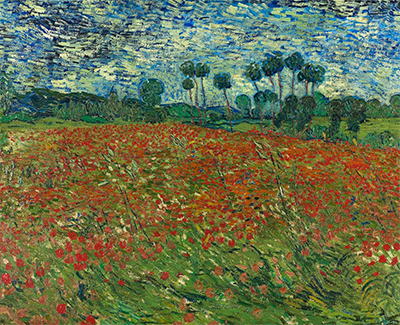Poppy Field was painted by Vincent Van Gogh in June 1890 just a month before he tragically took his own life. He was living in Auvers-sur-Oise where he had moved in May 1890 to be nearer to his brother Theo.
It was a hugely productive period which saw the troubled artist complete 106 pieces of work in just nine weeks. The poppy was a subject matter Van Gogh returned to often, producing seven paintings involving poppies between 1886 and 1890.
Van Gogh had been struck by the beauty of Auvers, an area which seemed to represent his ideal of natural beauty. Poppy Field is an oil on canvas work which depicts the beautiful reds of the poppies, the stark greens of the surrounding landscape and the wispy whites of clouds across a blue sky.
Yet the image still maintains an air of turmoil created by the wind as it blows the poppies to one side and makes the clouds quickly scuttle across the sky. There is lovely depth to the painting, but you are left in no doubt the poppies are the focal point.
Vincent Van Gogh had written to his brother to say ‘Auvers is very beautiful’ and Poppy Field was one of the paintings he produced as he wandered the landscape depicting this natural beauty. The poppy is a striking plant, one other artists had used in their work. Van Gogh’s Poppy Field is very similar in style to a work by Claude Monet from 1881.
However, Monet’s painting gives the impression of stillness on a summer’s day, little breeze disturbing a landscape dominated by sky. In the Poppy Field Van Gogh elevates the poppies, defining them as the central theme while adding depth with trees and distant hills.
Artists including Monet, Paul Gauguin and Henri de Toulouse-Lautrec helped inspire Van Gogh’s work. Poppy Field reflects his post-impressionist style, using bold, expressive colours and it is a style which has inspired artists through the years and continues to do so today. Van Gogh produced over 2,100 artworks during his life, yet Poppy Field was to be one of the final pieces by this master of his craft.
In this painting the broader brush strokes of his Auvers works are in evidence. There is movement in the pictures of this period, illustrating the natural movement of the landscapes he saw. It creates a sense of life in the image. Yet that air of turbulence created by the breeze is never far away.




